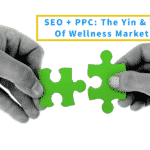Many corporate wellness companies send a corporate wellness sales proposal after their first conversation with a potential customer – only to find themselves out of ideas when absolutely nothing happens after that.Yet, just as it’s not realistic to propose marriage on the first date, it’s not realistic to expect to close a sale to an employer you’ve just met.
Here’s a step-by-step approach that advances only when your prospect takes actions that demonstrate serious interest:
1) How about a cup of coffee?
Begin with a no-pressure invitation to get to know your business that makes it easy and appealing to say “yes”.
For example: using direct mail, paid search and/or organic search, offer a free white paper that can be downloaded from your website on an important and interesting topic. A possible topic for workplace wellness providers: “Best Practices: Five Ways Retailers Lower Their Disability Costs.” Draw on your own customers’ success stories.
Another option: “Buyers Guide: Workplace Wellness Providers.” Offer a thorough set of decision criteria accompanied by handy tools like self-assessments (“Estimate ROI For Your Workplace”) or checklists (“How To Introduce Wellness To Your Workplace”).
Require only essential contact information. By essential, we mean the information necessary to follow up in the next phase of your marketing process – typically name, title, company, mailing address, email address, telephone number. Do not waste your prospects’ time with lead generation questions that are notoriously unreliable and offer only the illusion of actual information: “Do you plan to buy within six months?”.
2) Could we double-date with friends?
After your prospect downloads the white paper in Step 1, follow up within one to two weeks with a low-pressure invitation via email or telephone call to a webinar or in-person event.
The structure for your online or in-person event is almost endless. For example, panel discussions with multiple experts are a great draw. You could invite HR directors from three of your clients to discuss the challenges they overcame in introducing workplace wellness programs at their companies.
Regardless of format, however, your goal is to emphasize the expertise and experience of the presenters, the quality of the individuals attending, and the highly informative “news you can use” nature of the content.
Allow about one-third of the allotted time for Q&A and interaction. Mine the information revealed during discussion for 1) insights into what prospects want to know about and 2) the names of attendees who seem most serious at this point about pursuing a purchase.
We suggest offering a rotating menu of lead generation seminars. Identify three to five topics that resonate with prospects and offer one every month.
3) Dinner with the parents?
Track who attends your webinars. Let’s say your firm indeed offer five rotating webinars on various aspects of workplace wellness. Once a prospect has attended three of them, reach out with a “Can we help?” email or telephone call.
Your goal is to elicit their concerns and goals — what else would they like to know about implementing workplace wellness programs? what’s motivating their interest? what are their fears about moving forward? — while looking for opportunities to share your clients’ successes. Avoid lecturing them on public health issues like the “problem of obesity in America.” Keep the conversation focused on what they care about – productivity, employee satisfaction, the bottom line.
Early in the relationship, start fleshing out the business case for workplace wellness with a focus on the cost and pain points they’re currently experiencing as a result of drivers like healthcare costs and claims, disability costs and claims, presenteeism and/or absenteeism. However, remember that not all prospects will care about each of these issues equally.
And of course, apply your usual sales strategy and prospect qualification techniques to determine what their needs are, how your company can solve them, how serious they are about buying, who the key influencers and ultimate decision-makers will be.
4) Do you want kids too?
When your prospect is ready to talk commitment, sketch out what they want – and what your company will do – in conversation and informally on paper before you agree to send a formal written proposal. When we say “sketch it out informally on paper” that’s exactly what we mean. Tear out a sheet of paper from your notebook and jot down the key elements of the agreement IN DETAIL as you discuss them with the prospective client. Include next steps – how will it get decided, who will decide it, by when, what items or information will they need to take action.
This step usually extends over several different meetings. And it often uncovers an important reality: that the person you’re talking with is merely a go-between – neither an influencer nor a decision-maker. Watch for frequent comments like “I don’t know how they’ll want to do that” or “That’s not my call” or “That’ll be up to Joe in Dept X to decide.”
You’ll know you’re done when you’ve resolved and jotted down everything that would normally be spelled out in a customer contract AND your prospect has added his detailed next steps as well.
Then, and only then, are you ready to send a final written contract. Notice that our approach skips the proposal step entirely. We don’t provide anything elaborate in a formal document until we’ve agreed in conversation on everything that will be in it AND what will happen when they get it.
5) Let’s set a date!
While you’re waiting for the final signed agreement, keep moving on implementation. That helps create impending events which reduce the likelihood that your agreement gets lost on someone’s desk.
In addition to the tasks required to actually roll out your services, go ahead and schedule executive-level “results reviews” at least 30, 60 and 90 days out.
You’ll want to schedule these reviews both internally, within your company, and with your client.
The internal reviews keep things on track by keeping the implementation project highly visible and identifying senior managers who are accountable for promptly resolving issues as they emerge. This approach sharply reduces dithering or arguing with other departments down in the trenches over resources.
The equivalent reviews with your client’s key senior managers offer similar escalation resources – but even more importantly, they make it much easier to build an ongoing relationship at a strategic level with your customer. Otherwise, you’ll find that you only have relationships with your day-to-day contacts – and those relationships focus on day-to-day details, nothing big-picture.
Once the initial implementation is behind you, shift to a quarterly schedule of client meetings. Focus on measurable results that tie back to their original goals and expectations for the project. Each quarter, revisit the original assumptions about participation, average cost, etc.. Update the numbers based on actual experience and provide modified projections based on that information.




